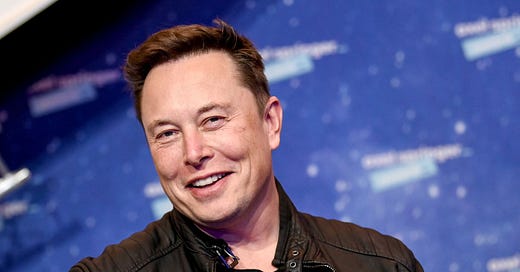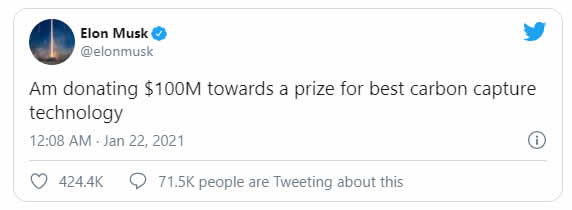Graphene & Elon Musk. Batteries? Not this time
Elon Musk has offered to award $100 million (more information yet to be provided) regarding Carbon Capture Technology.
Elon Musk has offered to award $100 million (more information yet to be provided) regarding Carbon Capture Technology. Regardless of the financial incentives, I hope that he [Elon Musk] and many others yet can help the development and applications of Graphene.
Musk, the CEO of Tesla and SpaceX who briefly passed Amazon CEO Jeff Bezos as the world's richest person before a slide in Tesla's stock price dropped him back a spot, recently asked his Twitter followers for advice on how to best give away his money.
Still, Musk's proposed carbon-capture contest would go toward a cause that is likely to play a major role in fighting climate change moving forward, especially under the Biden administration.
Carbon Capture
Carbon capture, which is also called “carbon capture and storage” (CCS), is what people call processes that involve capturing carbon dioxide (CO2) at the source of emission and sequestrating in order for it not to leak into the air.
It also sometimes involve technologies to use to the carbon for other purposes.
The concept has been suggested as a potential solution to slow down climate change by reducing the amount of carbon dioxide emitted in the atmosphere or even reversing it in the future.
However, current carbon capture technologies have often proven inefficient and add cost to energy production – making it uncompetitive without carbon prices.
Is the Graphene the solution? “Graphene membrane proves adept at capturing carbon dioxide”
Scientists led by Kumar Varoon Agrawal at EPFL (Ecole Polytechnique Fédérale de Lausanne) Valais Wallis in Switzerland have now developed a new class of high-performance membranes that exceeds post-combustion capture targets by a significant margin. The membranes are based on graphene, an atom-thick sheet of carbon, with a selective layer thinner than 20nm. They are highly tunable in terms of chemistry, meaning they can pave the way for next-generation high-performance membranes for several critical separations. The scientists describe the new membranes in a paper in Energy & Environmental Science.
This illustration shows how CO2-selective polymeric chains anchored on graphene effectively pull CO2 from a flue gas mixture. Image: KV Agrawal (EPFL).
Current membranes for carbon capture are required to exceed 1000 gas permeation units (GPUs) and have a ‘CO2/N2 separation factor’ – a measure of their carbon-capturing specificity – above 20. The membranes that the EPFL scientists developed show a six-fold higher CO2 permeance, at 6180 GPUs, with a separation factor of 22.5. The GPUs shot up even further, to 11,790, when the scientists optimized the graphene’s porosity, pore size and functional groups (the chemical groups that actually react with CO2), while other membranes they made showed separation factors up to 57.2.
"Functionalizing CO2-selective polymeric chains on nanoporous graphene allows us to fabricate nanometer-thick, yet CO2-selective, membranes," says Agrawal. "This two-dimensional nature of the membrane drastically increases the CO2 permeance, making membranes even more attractive for carbon capture. The concept is highly generic, and a number of high-performance gas separations are possible in this way."
(Remember that this newsletter is more or less weekly, but not always free. If you don't want to miss an issue or any of the special essays, all of which are paid for, you can become a monthly or annual subscriber: click below on "become a paying subscriber" and choose the plan you prefer).






